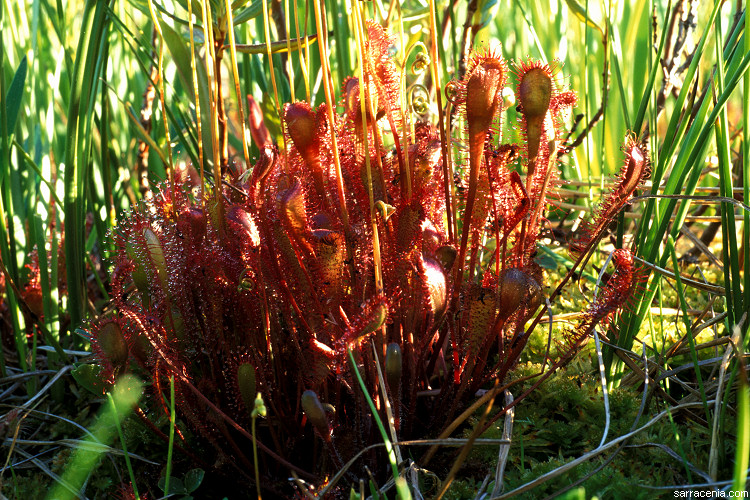
The hybrid:
This plant in the glaring sun
looks a lot like
Drosera anglica, but it ain't. The leaves are a little
shorter and the
plant is a little clumpier than you would expect for
Drosera anglica. In fact, it is the hybrid between
Drosera anglica and Drosera rotundifolia. It is called
Drosera ×obovata.
It is sometimes hard to tell whether a plant at this lake is
Drosera anglica or Drosera ×obovata, and I expect
you might want to argue with me about this photograph. (And maybe you
would be right!) I have seen many plants on the mat which I couldn't make
a call on. It is a lot easier in the fall, though, because during that season
the flower stalks of Drosera anglica are all plump and full of seed
while the stalks of Drosera ×obovata are skinny and empty
(the hybrid is normally sterile, although I know of at least one mad
scientist-horticulturist trying to change that). Also,
Drosera ×obovata tends to make thicker, more luxuriant clumpy
stands of plants
than Drosera anglica--this is because the hybrid vigorously
divides vegetatively.
Oh yeah, something else. I have seen Drosera anglica in Oregon, near
Mt. Hood,
and those plants do not have long leaves like the Californian
Drosera anglica. In fact, the Oregonian Drosera anglica look
a lot like the Californian Drosera ×obovata!
As you might guess, it is particularly tricky, in Oregon, to distinguish
the Drosera anglica from the Drosera ×obovata.
For example, both plants look very similar when young. However, at
maturity the Drosera ×obovata has
leaves with outlines intermediate in size and form between the
D. rotundifolia and the "short-leaved"
Drosera anglica. Also, the hybrid is sterile, so in the fall
they can be easily distinguished by the contents of the fruit.
Interesting stuff.